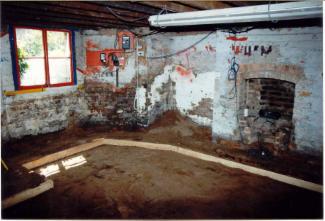Penetrating Damp
The typical causes of penetrating damp to properties above ground include the following:
Cracks and unsealed joints, cracked and damaged rendering, brickwork in need of pointing, missing or damaged roof tiles or slates, faulty guttering, missing down pipes, missing flashings , un-swept and blocked chimneys with broken chimney pots or missing cowls, and badly fitted windows.
All of the above raise the instance of water running down external walls and increase the likelihood of water soaking into the wall as it does so.
Another common form of dampness in outside walls is cavity wall tie failure, which can allow water penetration through both inadequate mortar joints (pointing) and also allow water to travel across the corroded wall tie through the internal skin of the brickwork.
B.Barker Damp Control & Timber Preservation provides the following treatment to remedy the problem:
• The external cause will be determined and the customer will be advised of the necessary action to prevent further water penetration.
• Internally, all plaster and backing coats will be removed from the affected area, followed by the appropriate preparation of wall surfaces before the application of a waterproof sand & cement render and a plaster finishing coat.
• Externally, it may be appropriate to apply an external masonry sealer.
Below ground level, basement areas and retaining walls are particularly prone to penetrating damp due to increased water pressures. In most cases below ground moisture will pe
The typical causes of penetrating damp to properties above ground include the following:
Cracks and unsealed joints, cracked and damaged rendering, brickwork in need of pointing, missing or damaged roof tiles or slates, faulty guttering, missing down pipes, missing flashings , un-swept and blocked chimneys with broken chimney pots or missing cowls, and badly fitted windows.
All of the above raise the instance of water running down external walls and increase the likelihood of water soaking into the wall as it does so.
Another common form of dampness in outside walls is cavity wall tie failure, which can allow water penetration through both inadequate mortar joints (pointing) and also allow water to travel across the corroded wall tie through the internal skin of the brickwork.
B.Barker Damp Control & Timber Preservation provides the following treatment to remedy the problem:
• The external cause will be determined and the customer will be advised of the necessary action to prevent further water penetration.
• Internally, all plaster and backing coats will be removed from the affected area, followed by the appropriate preparation of wall surfaces before the application of a waterproof sand & cement render and a plaster finishing coat.
• Externally, it may be appropriate to apply an external masonry sealer.
Below ground level, basement areas and retaining walls are particularly prone to penetrating damp due to increased water pressures. In most cases below ground moisture will pe
netrate through up to ground level, therefore all plaster and backing coats will need to be removed up to the DPC level and treated for moisture ingress.
Triton TT55 Cementitous Tanking system; involves applying two coats of waterproof sand and cement render onto prepared brickwork or block work. Then applying a Cementitous waterproof tanking mix over the render followed with a further coat of waterproof render.
When dry the area can be finished with plaster if necessary.
Triton TT55 Cementitous Tanking system; involves applying two coats of waterproof sand and cement render onto prepared brickwork or block work. Then applying a Cementitous waterproof tanking mix over the render followed with a further coat of waterproof render.
When dry the area can be finished with plaster if necessary.
Triton Cavity drain membranes ; provide an alternative to conventional cementitious tanking systems, which work by holding the water back. Cavity drain membranes work on the principle of allowing water to continue to penetrate the structure but control it in the air gap and divert it to a suitable drainage point. They do not allow pressure to build up against the internal construction and the air gap behind the membrane allows the structure to breath and to some extent to dry out. The membranes are loose laid on floors and fixed to walls using special plugs and sealing materials, with little or no preparation required to the substrate. Once the membrane has been fitted, wall surfaces can be dry lined or plastered directly and floors can be screeded or a floating dry board system installed.
0800 0327088 or 07887502911
0800 0327088 or 07887502911




